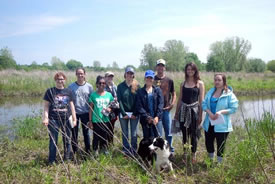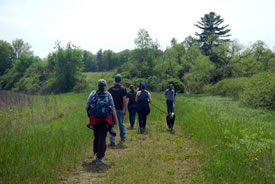Creating connections in Norfolk County

University of Waterloo environment & resource studies students at Long Point, ON (Photo by Brian Craig)
This spring, eight students left the lecture halls of the University of Waterloo and travelled to the Long Point Biosphere Reserve in Norfolk County, Ontario to discover ecological restoration in practice. The University course was taught by Brian Craig, a restoration-savvy community member and previous Parks Canada/Environment Canada ecologist. We came with the hopes of seeing our readings come to life, experience projects that are happening on the ground, meet some experts and get some dirt under our fingernails! Here is the story of what we discovered and how the Nature Conservancy of Canada (NCC) is making conservation and restoration a reality. NCC unites members of the community with a love for their natural surroundings and backed by sound science to create real results.
If you’ve never been to Norfolk County, you are missing out! It’s a region with a great diversity of ecosystems, including Great Lakes marshes, Carolinian forests, tall grass prairie, cold-water streams, wetlands and the Long Point Inner Bay. Norfolk County is also blessed with productive agricultural lands. These ecosystems host arguably the greatest diversity of plants and animals in Canada. The region is home to many species at risk, such as the Blanding’s turtle, eastern foxsnake and American badger. Long Point and the surrounding area received a designation as a world biosphere reserve in 1986. Biosphere reserves are internationally recognized by the United Nations Education, Scientific and Cultural Organization (UNESCO) to act as an example of striking a balance between conserving ecosystem biodiversity and fostering sustainable use in the surrounding area.
There is an equally diverse range of citizen values and motivations in the region. Farmers, hunters, conservationists, retirees and cottagers populate the region. The Carolinian Zone is home to 25 percent of the country’s endangered species, but also 25 percent of Canada’s human population and some of the best agricultural lands — so you could see how this could be a challenge!
We visited a recently restored property in NCC’s Norfolk Forests and Long Point Wetlands focal area, where we learned about NCC’s conservation planning and restoration work. NCC has created the Southern Norfolk Sand Plain Natural Area Conservation Plan, which takes a big picture look at the natural area. Within the Norfolk Forests and Long Point Wetlands focal area, NCC has identified four key areas of existing natural habitat on which to focus its securement and stewardship:
- Backus Woods
- St. Williams Conservation Reserve
- South Walsingham Sand Ridges
- Long Point

University of Waterloo environment & resource studies students at Long Point, ON (Photo by Brian Craig)
NCC's goal is to build upon these blocks of existing habitat that connect the natural corridors along Big Creek, creating more interior forest habitat for rare species and positively impacting water quality flowing into the Long Point Inner Bay. These habitat corridors are essential for the genetic health of many endangered species.
Although conservationists, hunters and farmers often have very different interests, in Norfolk County they have come together to create habitat for wildlife. Hunting is a huge driver behind conservation. Long Point itself was owned and preserved by hunters before over half was donated to Environment Canada's Canadian Wildlife Service. In fact, a large portion of the habitat in Norfolk County is owned by hunters and managed for waterfowl. Without their dedication, these areas for wildlife may not exist!
As we met key players in the ecological restoration scene of Norfolk County and toured their projects, the puzzle pieces fell into place. For example, we learned about the Long Point Causeway, a stretch of road that is a death trap to many animals such as turtles and snakes that are trying to cross the road. Casualties include endangered species such as the spotted turtle. A group of concerned citizens spearheaded a movement called the Long Point Causeway Improvement Project, which successfully fundraised to build wildlife passages for the animals to traverse under the causeway. This effort has substantially reduced road kill and is restoring the hydrological connection between the Big Creek marsh and the Inner Bay. NCC was at the table to help initiate this project over seven years ago.
During our course we met with Mary Gartshore, a member of the Norfolk Field Naturalists, one of the founders of St. Williams Nursery and Ecology Centre and a prairie restoration expert. Among many things, she taught us the importance of using only genetically appropriate, locally sourced seeds and plants for restoration. NCC purchases these locally sourced and seeds and plants from the Nursery for restoration of their properties.
Another excellent example of the agricultural community contributing to conservation is the Alternative Land Use Services (ALUS) program. ALUS has a long history in Norfolk and was initiated by farmers for farmers. Chris Van Paassen, a farmer and conservationist, chairs the organization. Farmers rent their marginal farmland to ALUS, which in turn provides funding to restore the marginal land, creating habitat for wildlife. It’s a win win situation — farmers have the satisfaction of knowing they’re doing their part to conserve a part of this unique biodiverse region, while receiving modest remuneration for providing ecosystem services.
These are only a few of many examples of federal, provincial, municipal, conservation authority and privately owned restoration efforts that are contributing to biodiversity conservation in the region. NCC has used sound science to create a vision and plan for increasing and connecting the native habitat of Norfolk County, as well as supported and partnered with many organizations and individuals in the region. With continued community collaboration, the future looks bright for Norfolk County’s rare Carolinian forest ecosystems and all the creatures that inhabit them.


